5 Science Experiments for Kids Related to Teeth


Using Engaging Science Experiments to Teach Your Child
When it comes to your child’s oral health, one of your major tasks as a parent is teaching them about the importance of a great oral hygiene routine and integrating this routine into their day. Getting your child interested in oral hygiene might feel like a struggle at first, but there are actually plenty of fun activities and experiments you can use to get your child engaged and interested in their oral health while showing just how important oral hygiene is. The lessons you’re trying to teach will better stick if your child is engaged and having fun — and it’ll be more fun for you, too! Plus, starting this process early builds healthy habits in your child and protects their teeth and gums in the long run, helping them stay healthier well into adulthood. Here are a few science experiments you can try at home to entertain, teach, and engage your little ones!
Egg Brushing
Eggshells are made from calcium, so they make an easily accessible comparison to tooth enamel for home science experiments. This experiment involves soaking hard-boiled eggs overnight in different types of liquids, including water, a dark-colored soda, and vinegar. Give your kids the chance to guess what they think will happen to each egg, then check the eggs in the morning. The egg that was soaked in soda will be stained brown, so it will look the most different visually, but the shell of the vinegar egg will be squishy!
You can explain why these changes happened and how it relates to your child’s own teeth, and then you can drive home the importance of brushing their teeth with one final step. Give your kids a toothbrush and let them try to brush the stained egg with water, then with toothpaste. While the stain won’t come off with just water, a little elbow grease and toothpaste should start to get the egg clean. It’s a great way to show your kids how much the foods and drinks they consume can change their teeth and how important brushing their teeth with toothpaste really is!
Revealing Plaque
Plaque is usually pretty hard to spot while it’s on your child’s teeth, so it’s often hard for children to relate to the need to get rid of it. After all, seeing is believing, and your kids can’t see the problem you’re talking about! Thankfully, there’s some very fun and eye-opening science experiments you can do at home to help your child see the plaque on their teeth. Disclosing tablets are chewable tablets that turn the plaque in your children’s mouths bright colors. Your children will love the colors, but it’s also a great way to help them relate to and better understand the importance of good oral hygiene.
Since chewing the tablets before they’ve brushed their teeth will make it easier for your children to locate and clean all the plaque from their mouths, this experiment can also help them learn to be more thorough during their oral hygiene routine. Using a tablet after they’ve already brushed their teeth can also reveal spots they’ve missed, helping them to go back and get those spots more thoroughly. Whether you use it as a one-time experiment or regular aid to help your child learn to brush their teeth better, it can be both a fun and educational activity that helps them improve their oral hygiene routine.
Homemade Toothpaste
Making toothpaste with your kids is a fun way to get them involved in their oral hygiene routine. Plus, just like any time you make something with your kids, it’s a great opportunity for bonding time. It’ll feel more like a fun craft or cooking project for your kids than it will a science experiment or a learning experience! There are plenty of homemade toothpaste recipes, including several specifically meant for kids and designed to taste better to them, so you can pick a recipe that sounds good to you. While you make the toothpaste, you can explain why different ingredients are going in it or talk about how toothpaste helps keep teeth healthy. Working with measurements even allows you to fit in a little practice with numbers or math concepts for your little ones, so this can be a fun but very educational activity for your kids!
Growing Plaque
We always tell kids that bacteria feed on sugar, but this science experiment is a great way to show them just how big of an impact sugar can have! It’s also an incredibly simple experiment that can be done with ingredients you likely already have at home. All you need to do is mix warm water and yeast in two cups, then add sugar to one of the cups. Be careful to stir the mixtures with different spoons so that no sugar makes it into your sugar-free mix. As you mix the ingredients, you can explain that like the bacteria in your mouth, yeast thrives off of sugar. Then all you have to do is wait and watch! The cup that has sugar in it will foam a lot, potentially even overflowing. Seeing this reaction can help show your child what’s happening in their mouth, even if they can’t see it. You can then explain how flossing and brushing their teeth protects their mouth from bacteria and keeps their teeth healthy.
Elephant Toothpaste
Making “ elephant toothpaste ” doesn’t provide a result that your kids can use to clean their teeth — it just creates a fun chemical reaction that results in foam. When you create this mixture in a bottle, the foam erupts from it in a way that looks like toothpaste being squeezed from a tube. It’s still an incredibly fun experiment that provides an opening for you to talk about toothpaste and how it helps keep teeth healthy. It also has value in the way it’s able to also teach your child about science and chemical reactions. Younger kids will simply think it’s cool that the bottle heats up as the foam begins to form, but you can explain this chemical reaction in a little more detail to slightly older kids. The yeast works as a catalyst to separate the oxygen from the hydrogen peroxide and produce heat in the process, making the result a great example of an exothermic reaction. Your kids will have a blast with this experiment while learning about both science and oral health!
Children learn best when they’re engaged and having fun, so these science experiments allow you to meet your children at their level. Your kids will have a blast, but they’ll also be able to learn through experiencing the concepts you’re talking about, giving them a better long-term understanding of just how important it is to take good care of their oral health. Your children will carry this understanding and the related habits you’ll help them form into adulthood, impacting their oral and overall health for a lifetime.
Science Project For The Effects That Beverages Have On Teeth
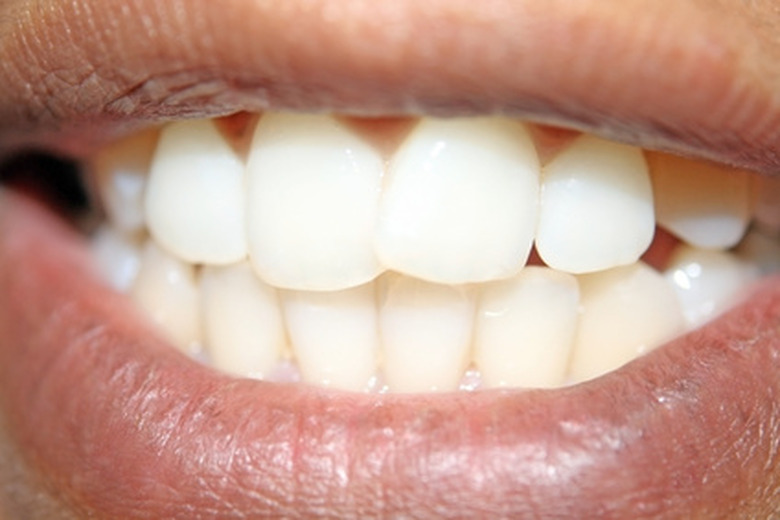
The acids in many beverages can have a damaging effect on your teeth. Demonstrating this makes a great science project for school science fairs or classes. If you have lost a baby tooth lately, you could experiment on actual teeth, but if not you can substitute eggshell. Eggshell is not as tough as human teeth, as it lacks a layer of enamel, but it does provide a graphic example of the effect some beverages have on your teeth.
Comparing Beverages
Compare the effects of different drinks on your teeth using eggshell as substitutes for teeth. Choose a variety of drinks to test, such as:
• milk • juice • soda • coffee • sports drinks
For each drink, place a piece of eggshell in a glass. Make sure you use the same size eggshell in each glass. Fill each glass half-full with the different drink. Each day, remove the eggshell from each glass and examine it. Write down what changes have occurred. Repeat this for five to seven days.
Drink Stains
Some beverages can also stain your teeth. For this activity, use beverages of different colors, such as:
• colas • root beers • orange soda • juices
Pour each beverage into a glass. Place a piece of eggshell into each glass. The eggshells should remain in each glass for the same period of time. Place one eggshell in a glass of water to act as a control. Remove the eggshells after the allotted time and determine which one has received the most staining.
Tooth Brushing
Demonstrate whether brushing makes a difference. Fill two glasses with cold coffee (without milk or sugar added). Place a hard-boiled egg in each glass. Leave the egg in for 10 minutes and then remove the eggs. Carefully brush one of the eggs, using a toothbrush and toothpaste. Let both eggs dry and then repeat the activity four or five times. Decide which egg is more stained.
Comparing Acids
Different sodas have different types of acid in them. The most common types of acid used in soda are citric acid and phosphoric acid. You can find which acid is in each soda by looking on the list of ingredients on the label. Pour some of each soda into separate glasses and place a piece of eggshell into each glass. Leave the shells for one day and then remove them and examine them. Figure out if one shell shows more wear than the other. Continue the experiment for several days.
- Healthy Teeth: Acid Attack
- Julian Trubin: Science Fair Project: Dentistry
Cite This Article
Magloff, Lisa. "Science Project For The Effects That Beverages Have On Teeth" sciencing.com , https://www.sciencing.com/science-project-effects-beverages-teeth-7892494/. 24 April 2017.
Magloff, Lisa. (2017, April 24). Science Project For The Effects That Beverages Have On Teeth. sciencing.com . Retrieved from https://www.sciencing.com/science-project-effects-beverages-teeth-7892494/
Magloff, Lisa. Science Project For The Effects That Beverages Have On Teeth last modified August 30, 2022. https://www.sciencing.com/science-project-effects-beverages-teeth-7892494/
Recommended
- Skip to primary navigation
- Skip to main content
- Skip to primary sidebar

- FREE Experiments
- Kitchen Science
- Climate Change
- Egg Experiments
- Fairy Tale Science
- Edible Science
- Human Health
- Inspirational Women
- Forces and Motion
- Science Fair Projects
- STEM Challenges
- Science Sparks Books
- Contact Science Sparks
- Science Resources for Home and School
Tooth decay experiment with egg shells
February 12, 2021 By Emma Vanstone 3 Comments
This fun tooth decay experiment with egg shells is all about teeth and how to keep them healthy. First we talked about how important it is to brush teeth everyday and then chatted about foods that are good for teeth and foods that aren’t.
Sugary, sticky food is not good for teeth as it sticks to the surface, bacteria then break down the sugar to make acid which can damage teeth.
Did you know eating cheese at the end of a meal can help neutralise the acids in your mouth and reduce the chance of tooth decay?
Tooth Decay Demonstration
We used these giant teeth from The Consortium and some play dough to demonstrate plaque building up on teeth. The giant teeth made a great prop and really kept the children engaged for a long time.

The we made models of our mouth using more play dough, talking about the size and shape of teeth in our jaw.
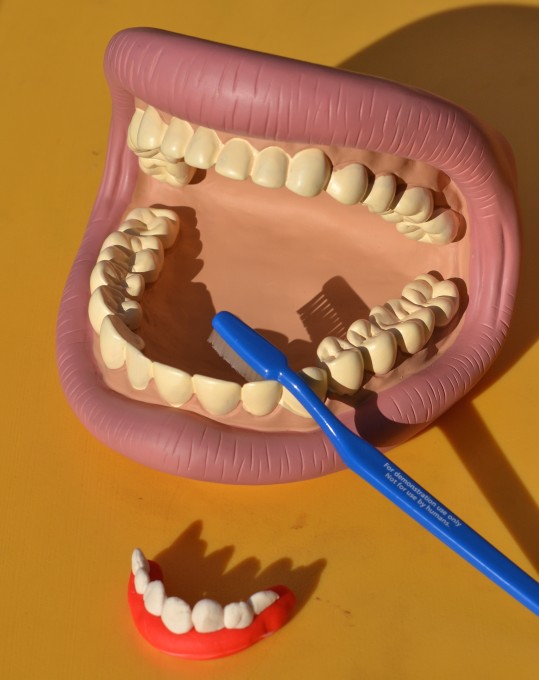
We can’t experiment on our own teeth so are using eggs to represent them, as the shell of an egg is made of a similar substance to tooth enamel!
What you’ll need for a tooth decay experiment:
Fizzy flavoured drink
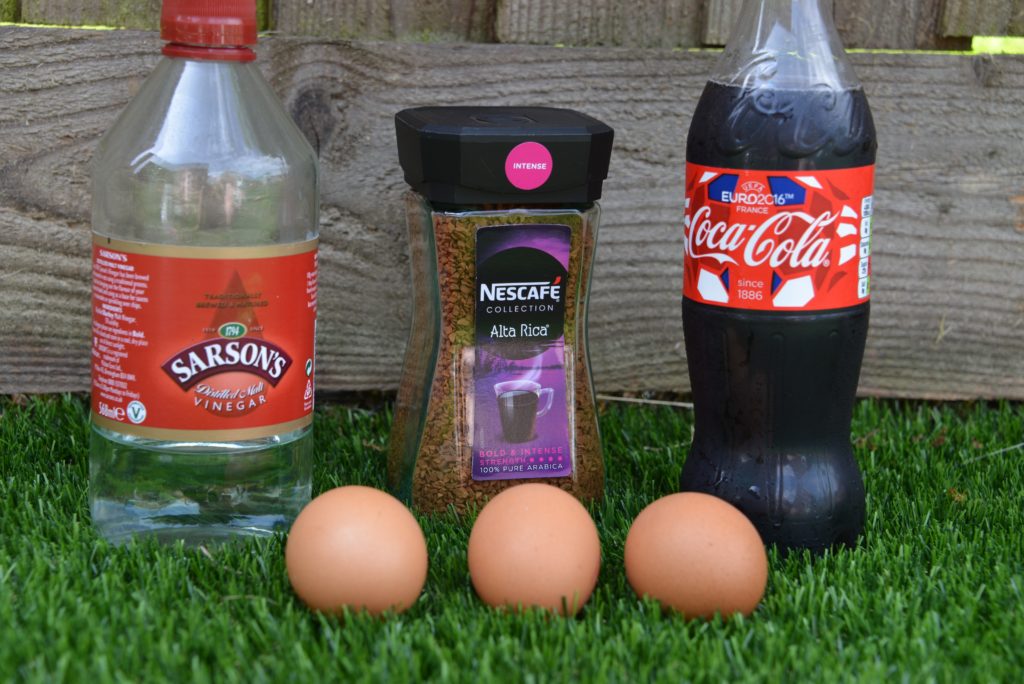
Instructions
- Pour the same amount of fizzy drink, vinegar, water and tea or coffee into your jars.
- Add a whole raw egg still in it’s shell to each, cover an extra egg with toothpaste and also place in tea/coffee.
- Leave for approximately three days.
- Remove the eggs.
- Rinse the egg kept in vinegar and rub gently until the shell comes away.
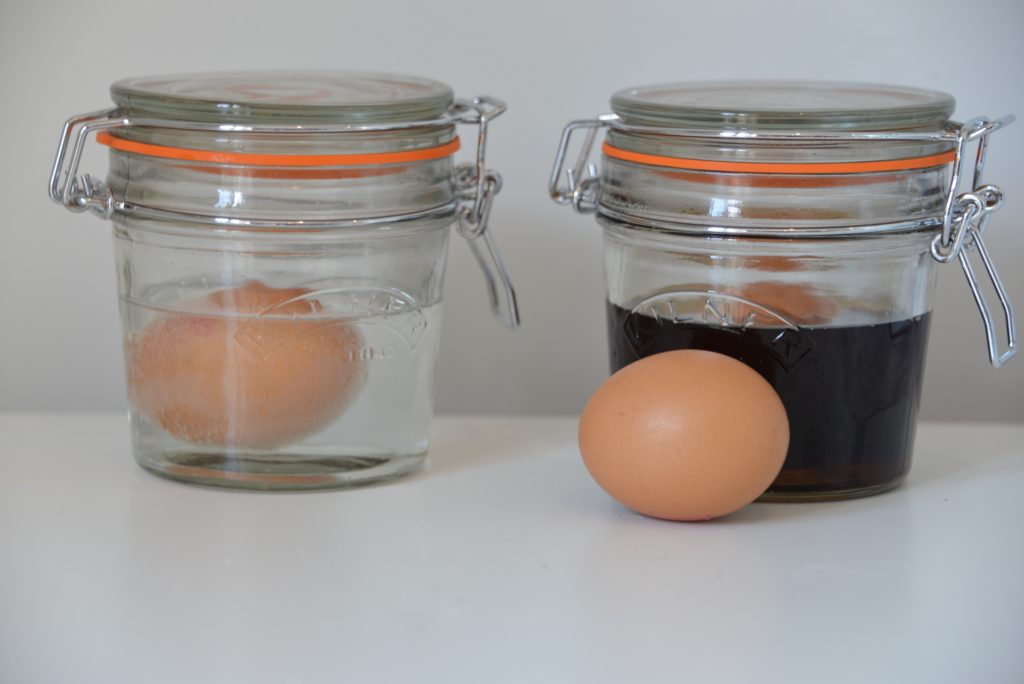
Results of our tooth decay experiment with egg shells
You should see staining on both the fizzy drink and tea/coffee egg.

We found our toothpaste covered egg stained less than the non toothpaste covered egg.
The vinegar completely dissolved the eggshell, leaving just the membrane behind.

Why do teeth stain?
Tea is rich in tannins which stain teeth if they’re not cleaned properly while cola and fizzy drinks are acidic as well as containing staining products.
Vinegar ( which is acidic) dissolves the calcium carbonate in the shell, leaving just the membrane intact. This very cool egg experiment lets you bounce an egg without it breaking!
Download the experiment instructions!
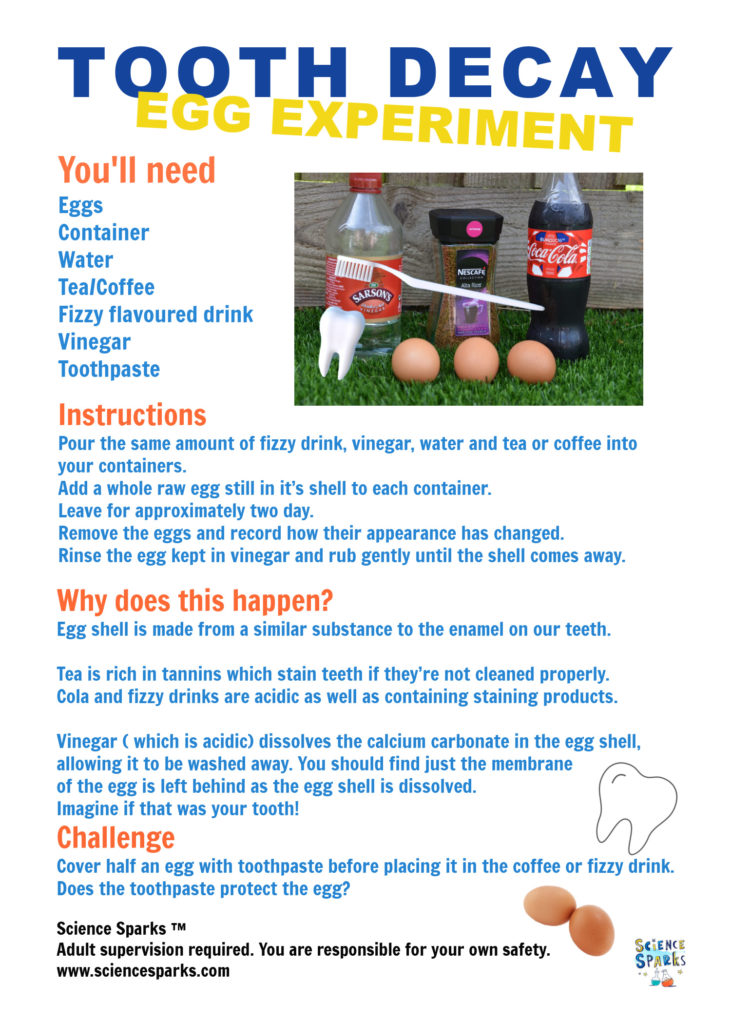
More egg experiments for kids
Did you know you can make a strong bridge from eggshells ?
Walk on raw eggs like Housing a Forest .
Make a model mouth using biscuits, marshmallows, jam and peanut butter. This disgusting activity is one of 60 Gross Science Experiments you can find in my latest book, GROSS SCIENCE .
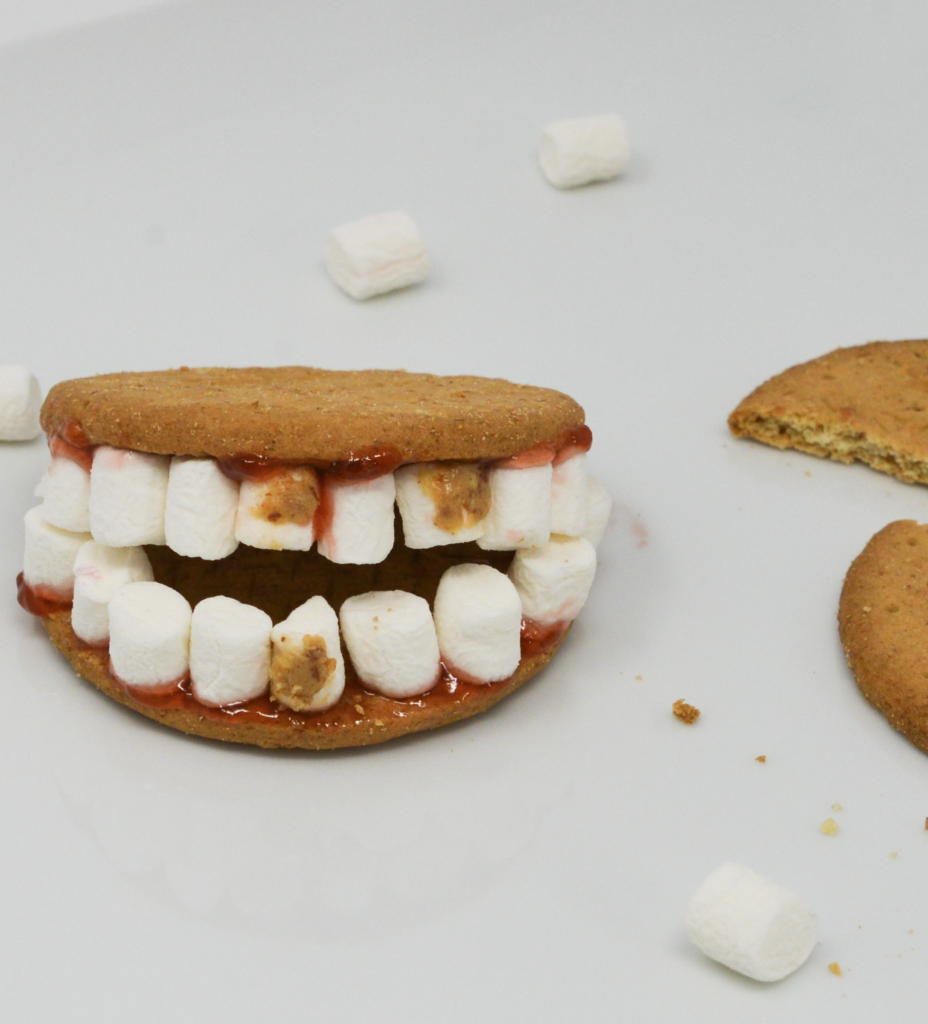
Or, how about trying one of my other very eggy experiments !!
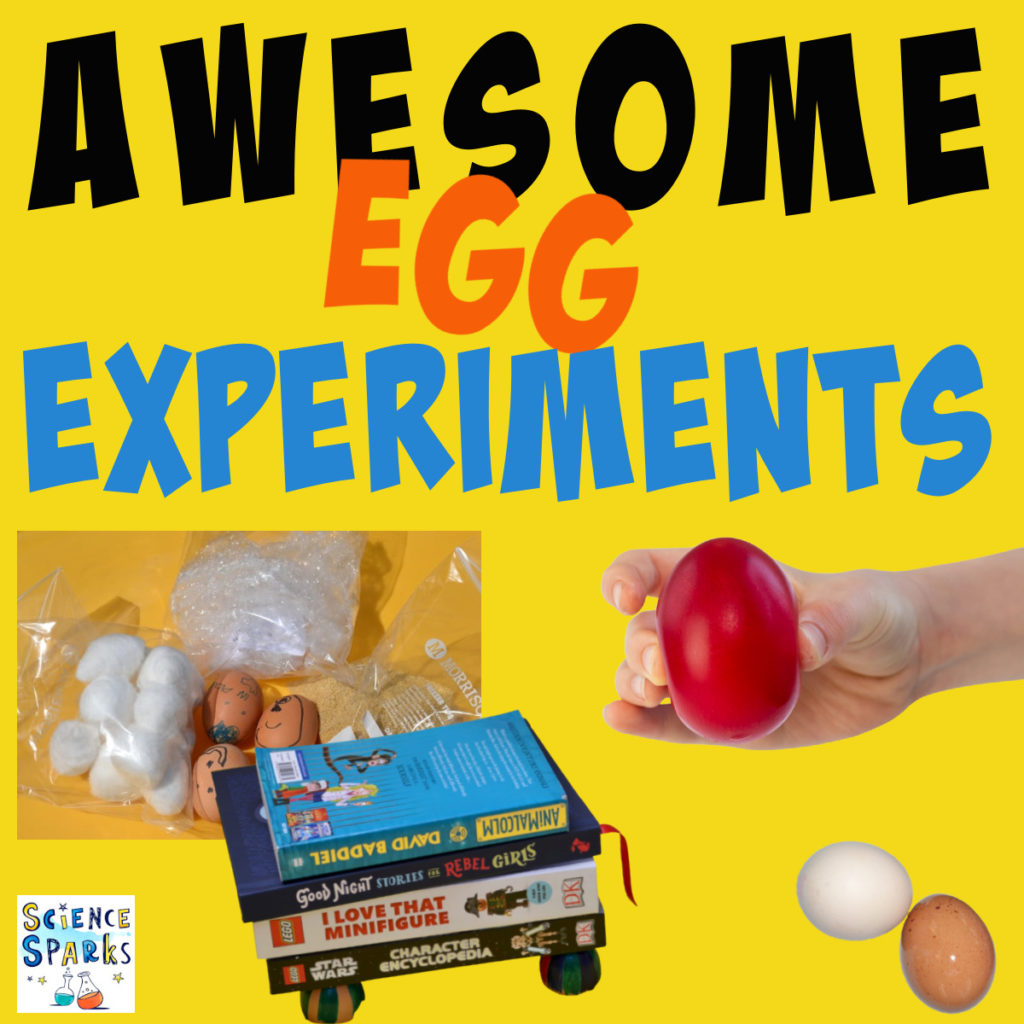
Extra background information for KS1 and KS2 Science
Teeth are not just for eating, animals often use them to defend themselves or to attack other animals.
Different shaped teeth have different purposes. Flat molars like humans have are for grinding and chewing food, while sharp canine teeth are for tearing food apart ( these are found in carnivores ) and large incisors for cutting and chopping grass ( found in herbivores ).
Caring for teeth
Cleaning teeth, using floss and mouthwash help keep teeth and gums free from plaque. Plaque is formed by bacteria feeding on the sugar left on the surface of teeth after eating.
Suitable for Early Years Foundation Stage
Physical development → health and self-care → elg.
- Children know the importance for good health of physical exercise, and a healthy diet, and talk about ways to keep healthy and safe. They manage their own basic hygiene and personal needs successfully, including dressing and going to the toilet independently.
Key Stage 2 – teeth test
Describe the importance for humans of exercise, eating the right amounts of different types of food, and hygiene.
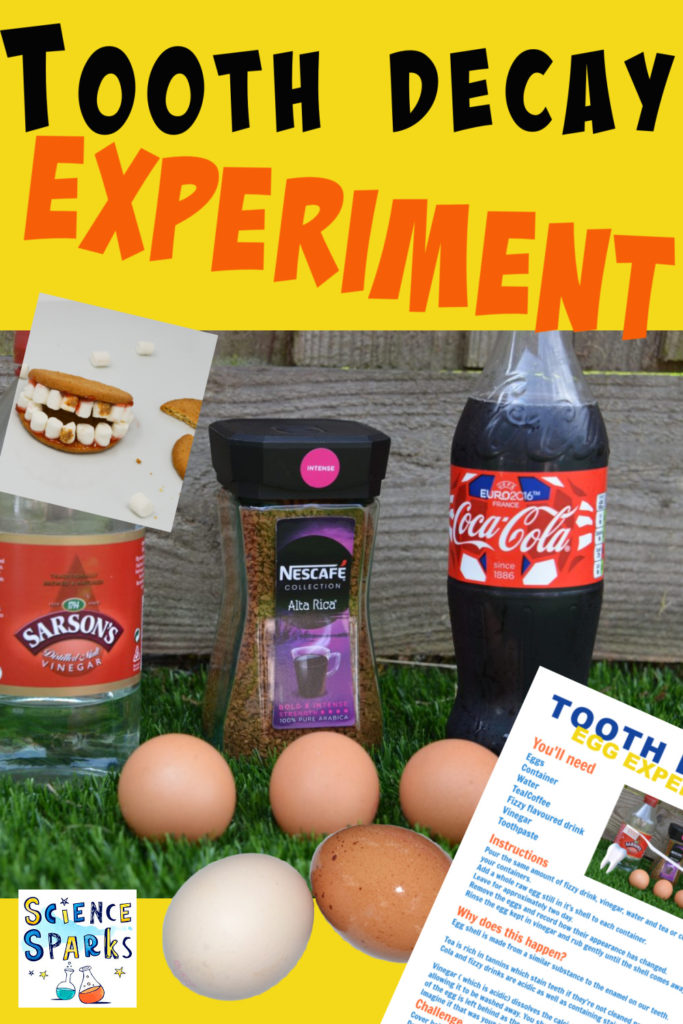
Last Updated on February 1, 2023 by Emma Vanstone
Safety Notice
Science Sparks ( Wild Sparks Enterprises Ltd ) are not liable for the actions of activity of any person who uses the information in this resource or in any of the suggested further resources. Science Sparks assume no liability with regard to injuries or damage to property that may occur as a result of using the information and carrying out the practical activities contained in this resource or in any of the suggested further resources.
These activities are designed to be carried out by children working with a parent, guardian or other appropriate adult. The adult involved is fully responsible for ensuring that the activities are carried out safely.
Reader Interactions
May 10, 2021 at 9:20 pm
Is there any other material one could use aside from an egge?
May 12, 2021 at 11:57 am
Small ceramic pieces would work too.
May 31, 2021 at 4:46 pm
This experiment is awesome!!!
Leave a Reply Cancel reply
Your email address will not be published. Required fields are marked *
- Skip to primary navigation
- Skip to main content
- Skip to primary sidebar

Last Modified: Jan 5, 2024 by Tara Gerner 100 Comments
What Do Sugary Drinks Do to Your Teeth? - Kids Science Experiment
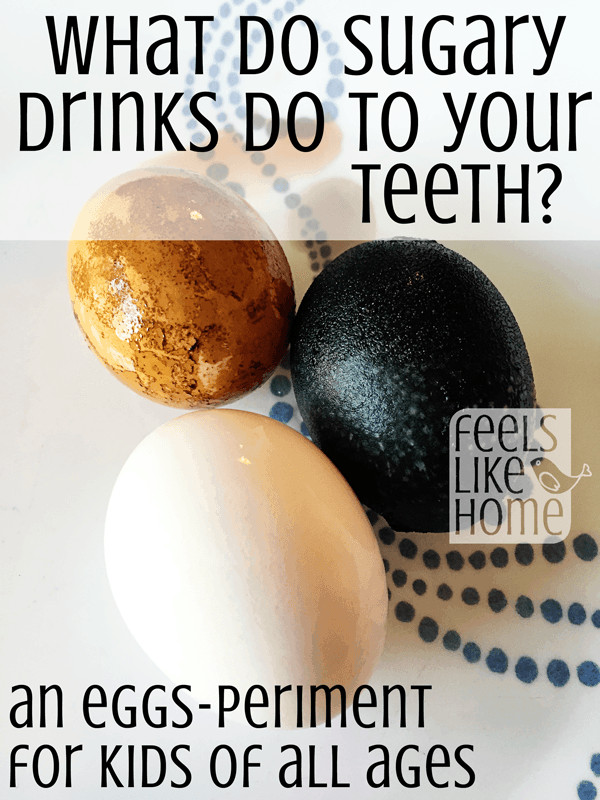
I hope you will enjoy this fun science experiment for kids. With some basic materials and a day of waiting, you can show your children what drinks like soda pop and fruit juice to do to their teeth and give them an idea of how important it is to brush every day.

My kids are pop fiends. (I know some of you are confused right now because you call pop soda .)
Probably because I am a pop fiend. They learn what they see, right?
It's not one of our finer points.
Anyway, I wanted to show the girls what pop does to their teeth because they are both kind of in a funk where they don't want to brush without a lot of prompting.
So we talked about how your tooth enamel is made of the same basic stuff (calcium) as eggshells (calcium carbonate, I think), and so we could soak some eggs in drinks that we like to see what would happen to them over time. The discoloration of the white egg would be similar to the discoloration of our white teeth over time.
The effects of different drinks, as you can see above, were striking. The kids, Allie especially, really got the idea that these drinks are harmful to her teeth, and she has since been brushing every day without any fuss.
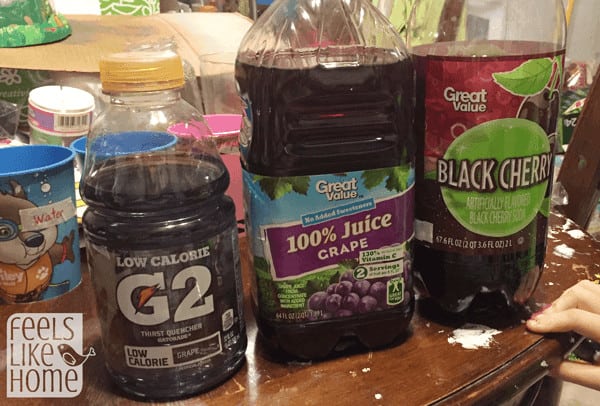
- 5 raw white eggs - Actually, they don't have to be raw, but they also don't have to be cooked, so I don't know why you would spend the time.
- 5 cups - I thought about buying clear plastic cups, but the liquid is dark, and you can't see the eggs anyway, so use whatever cups you already have.
- Masking tape
- A dark-colored sugar-free drink like Gatorade G2 or a diet soda
- A dark-colored fruit juice like grape juice
- A dark-colored flavor of regular soda or pop - we used black cherry but a cola like Pepsi or Coke would probably work better
- Orange juice (We only had 4 eggs left in the house, so we omitted orange juice, but I was really interested in what would happen with this. My dentist told me that orange juice is pretty close to the worst drink possible for my soft teeth because the acid attacks the enamel and the dentin inside.)
Instructions
- This one is super easy.
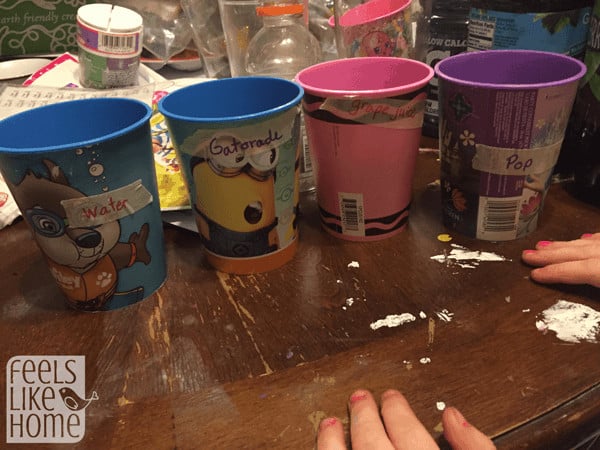
- Store your cups in a safe spot.
- Wait. Check your cups after a few hours if you want. We checked ours before we went to bed and then took them out after about 24 hours.
The Science

The hard shell of an egg protects the soft parts inside, just like the hard enamel on your teeth protect the soft and tender pulp on the inside. Both eggshells and teeth are made of calcium, a hard white substance that also makes up our bones.
Sugar and acids are very harmful to teeth. Acids actually dissolve the enamel, giving bacteria an inroad to begin decaying it, and sugar promotes tooth decay (cavities).
Of course, the water egg was the best after 24 hours. But take a look at the Gatorade egg:
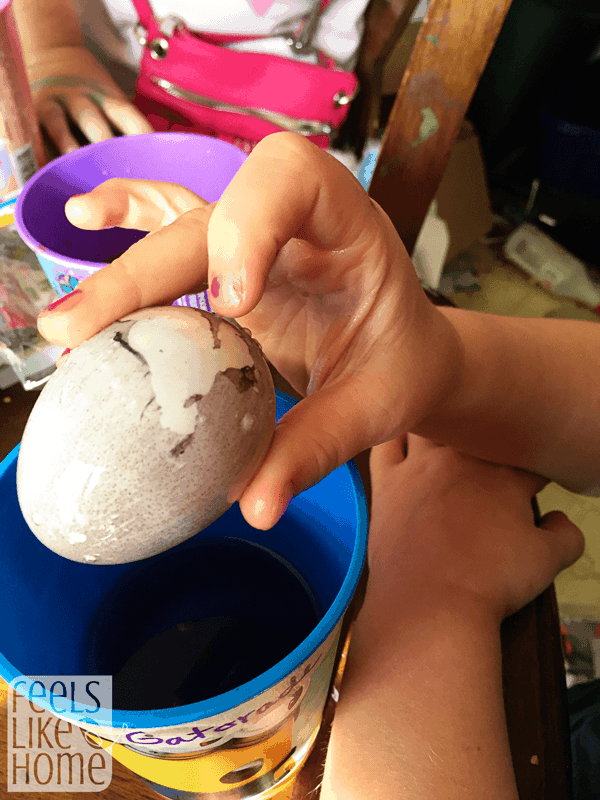
There was definitely a yucky-looking purplish coating on the egg, but it was fairly easy to wipe off with just our fingers. Unfortunately, the slime made the egg slippery and it fell on the floor before I was able to photograph it with the other eggs (in case you were wondering why there were only 3 eggs in the photos, now you know).
This was the black cherry pop egg:
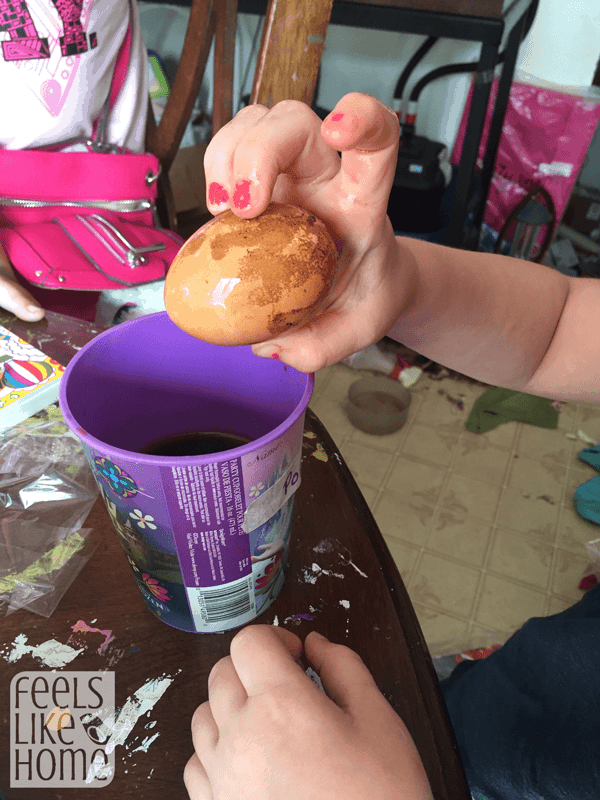
And this was the grape juice egg: (I love the shock on Allie's face here.)
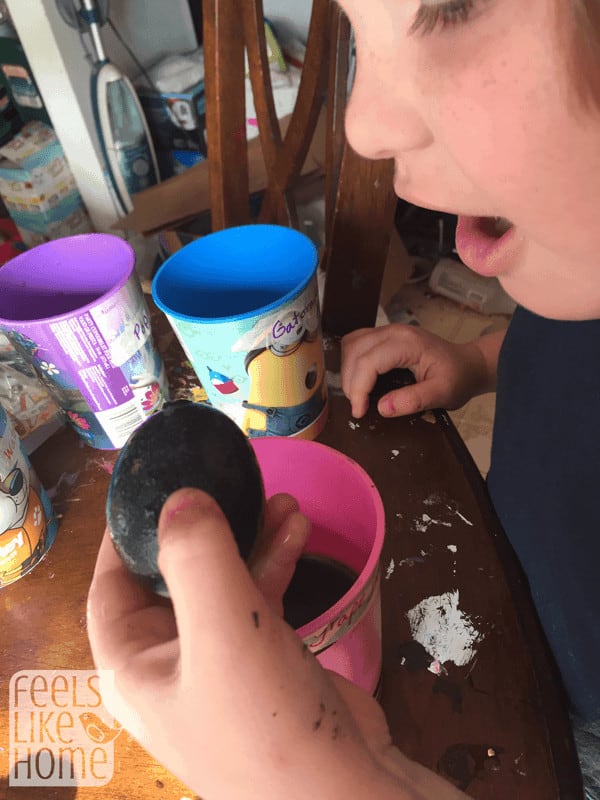
A study published in the journal General Dentistry found that pop is actually ten times more harmful in the minutes after drinking than is fruit juice. Our experiment showed that the discoloration from grape juice was a lot worse and longer-lasting, but it's not likely to cause actual decay as quickly as the pop would. So that part of the experiment was a little confusing.
The bottom line is that the sugar, color, and acids in our drinks harm our teeth, and those effects are exacerbated by poor brushing habits.
Extend the Experiment
Take this experiment a step further by brushing the eggs with a toothbrush and then with toothpaste and a toothbrush, to see how much of the stain can be removed from the egg and how much is left. It takes a lot longer than you think to clear away the stain, and you will probably find (as we did) that a lot of the stain is permanent.
More Cool Science Experiments for Kids
While you're here, check out a few of our other simple science experiments for kids:
- Paper Airplane Science
- Exploding Ivory Soap
- How to Grow Crystal Egg Geodes
- T-Shirt Chromatography
I hope you enjoyed this fun science experiment for kids . With some basic materials and a day of waiting, you can show your children what their drinks to do to their teeth and give them an idea of how important it is to brush every day.
More Elementary Aged Kids

Reader Interactions
Leave a reply cancel reply.
Your email address will not be published. Required fields are marked *
Swizel says
January 06, 2020 at 11:52 am
What precautions should be taken while doing the experiment
Carter says
January 29, 2020 at 1:35 pm
7th grade science fair is going grate!
February 10, 2020 at 3:38 pm
This project will work 100% YESSIR
March 01, 2020 at 9:42 am
How would you recommend graghing the eggs?
February 05, 2021 at 10:31 am
love this project imdoing for the science fair!!!! this is gonna be awesome!!!!
Joanne A. says
May 21, 2021 at 1:34 pm
I'm in third grade. I love this science experiment! I know I will get a prize!
May 24, 2021 at 12:56 pm
I don't know how to write a citation for this. I need it fast! My science project is due today!
May 24, 2021 at 1:07 pm
When was this page published?
Olivia P says
January 07, 2022 at 11:01 am
I really wanted to do this kind of project. When I found this website I got so happy. Thank you for helping me do my project. I hope to win a prize in my schools science fair and in the district science fair!
Emily F. says
November 06, 2022 at 5:23 pm
I am super excited to try this! It looks like a great way to learn about the way sugary drinks affect your teeth.
December 01, 2022 at 4:23 pm
Where is the control? Are you sure there are no other variables? Why didn't you use the same color egg for each one, you cant use brown eggs and white eggs that would change the outcome!
December 08, 2022 at 7:49 pm
i wanted to ask can i empty the inside of the eggs and then dip them in the liquid because i am scared my son might break the eggs Infront of the judges =D
Tara Ziegmont says
December 08, 2022 at 7:53 pm
Of course! It will still work.
December 13, 2022 at 1:46 pm
What is the Dependent Variable in the experiment?
October 30, 2023 at 4:34 pm
I"m doing this as a science fair project!!! I'm so exited! Thank you! The food on the side looked so good to. Can't wait to try
Privacy Overview

- 1 piece of cardboard
- 1 pair of scissors
- Modeling clay
- Plastic wrap

Short explanation
Long explanation.
- What differences are there between your teeth and the teeth of a friend of the same age?
- What differences are the between your teeth and the teeth of an older person?
- What differences are the between your teeth and the teeth of someone with all their baby teeth?
- Are there more similarities between your and a close relative's teeth, compared to someone you are not related to?
- What are the differences between the teeth in your upper jaw and lower jaw?

Rubber chicken bone

Water bowls

Strawberry DNA

Screaming dry ice

Dry ice in a balloon

Special: Dry ice color change

Dry ice smoking soap bubble snake

Dry ice giant crystal ball bubble

Dry ice in water

Rainbow milk

Gummy bear osmosis

Floating ping pong ball

Rotating Earth

Special: Colored fire

Special: Fire bubbles

Water cycle in a jar

Egg drop challenge

Taking the pulse

Orange candle

Glass bottle xylophone

Warped spacetime

Homemade rainbow

Water implosion

Warm and cold plates

Plastic bag kite

Tamed lightning

Yeast and a balloon

Forever boiling bottle

Moon on a pen

Moon in a box

Inexhaustible bottle

Crystal egg geode

Magic ice cut

Leaf pigments chromatography

Heavy smoke

Popsicle stick bridge

Micrometeorites

Special: Fire tornado

Special: Whoosh bottle

Dancing water marbles

Brownian motion

Flying static ring

Water thermometer

String telephone

Special: Dust explosion

Disappearing styrofoam

Special: Burning money

Special: Burning towel

Salt water purifier

Fish dissection

Hovering soap bubble

Homemade sailboat

Water mass meeting

Plastic bag and pencils


Water sucking bottle

Water sucking glass

Mentos and coke

Aristotle's illusion

Spinning spiral snake

Imploding soda can

Carbon dioxide extuingisher

Plastic bag parachute

Dental impression

Impact craters

Rolling static soda can

Static paper ghost

Color changing flower

Upside down glass

Shrinking chip bag

Solar system model

Electric motor

Flashy electric motor

Bouncing soap bubbles

Toilet paper roll maraca

Cloud in a bottle 1

Cloud in a bottle 2

Balloon rocket

Water whistle

Homemade yogurt

Special: Screaming gummy bear

Homemade compass

Trash airplane

Wind-up spinner toy

Tea bag rocket

Balancing soda can

Lung volume test

Fireproof balloon

Baking powder popper

Expanding space

Straw propeller

Wooden cutlery

Levitating match

Human reflexes

Electromagnet

Soil layers

Straw potato

Straw rocket launcher

Traveling flame

Straw duck call

Solar eclipse

Silo of salt

Balloon skewer

Newspaper tower

Microwave light bulb

Heavy paper

Homemade marble run

Drops on a coin

Cartesian diver
Content of website.


Egg and Soda Science Fair Experiment: Tooth Decay Project
Krystal DeVille
July 10, 2022
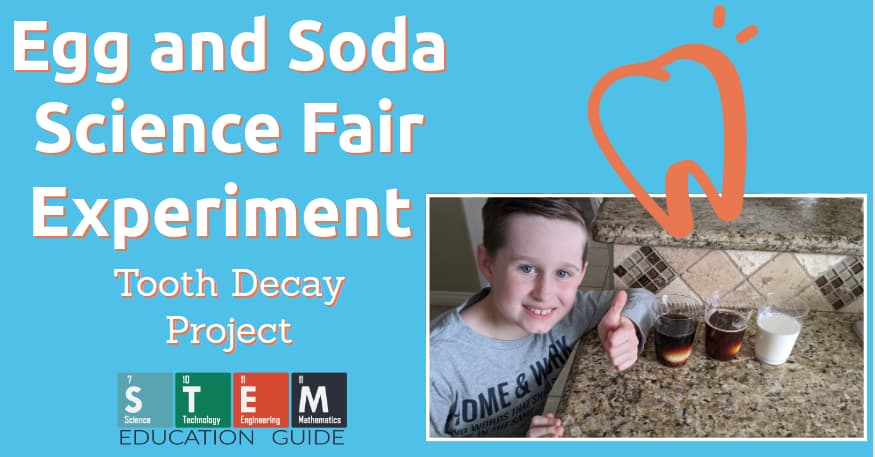
Healthy teeth are essential for your overall health!
They make it a breeze for our mouths to form words and flash million-dollar smiles. This importance in our lives is why we must pay attention to a potentially adverse problem: tooth decay .
Are you having a hard time getting your child to brush their teeth? If so, it might be time to bring out the big guns by introducing the egg and soda science fair experiment to explore the concept of dental health.
Theoretically, a hard-boiled eggshell works similarly to the enamel on your child’s tooth. It protects the dentin (the soft inside of a tooth) from damage.
Unfortunately, some of our dietary habits make it difficult for the enamel to protect our teeth from damage. This science experiment will demonstrate the repercussions of our choices on our bodies, and why tooth health matters. Read on!
Table of Contents
Egg and Soda Science Fair Experiment
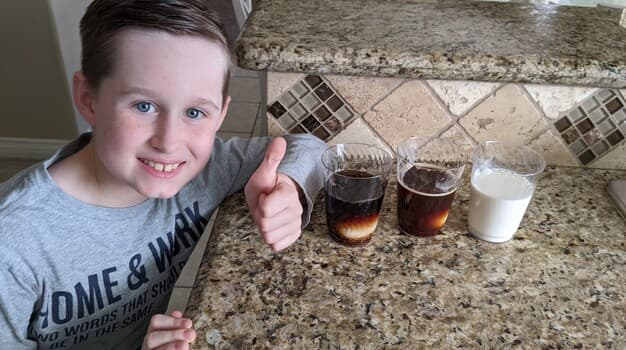
What You Need
The good news is that the egg and soda science fair experiment doesn’t require a myriad of pricey supplies. They’re wallet-friendly and there’s the likelihood that you have most of them in your home. If not, they’re readily available online and can be delivered to your doorstep.
- Three clear plastic cups
- Toothpaste and a toothbrush
- Three white-shelled hard-boiled eggs
Before the Egg and Soda Science Fair Experiment
Start by talking to your child about the importance of dental hygiene practices that include brushing their teeth twice a day.
Ensure you explain how certain activities, drinks, and food, can damage and stain teeth. You’ll also want to delve into how the consumption of acidic drinks can erode tooth enamel .
Ask your child to name a few types of drinks that are detrimental to their teeth. They may list juice, soda, or coffee because of the acid and sugar.
Furthermore, you can ask your child to think of drinks that can boost the health of their teeth. They might answer water and milk.
You can also find out if they believe brushing after the consumption of some of the harmful drinks can lower the risk of damage to their teeth.
Explain the Egg and Soda Science Fair Experiment
To spark their curiosity and pique their interest, inform your child that you have a way of discovering the repercussions of leaving those harmful drinks on their teeth overnight.
With a boiled egg in hand, demonstrate how it resembles their teeth (a thin and sturdy outer shell and a soft inside). Take the time to explain the consequences of leaving the egg soaked in soda overnight, compared to water.
Additionally, consider various types of soda such as colas that have varying effects compared to their clear lemon-lime counterparts.
Another fun experiment I did with my son was the Cloud in a Bottle project. You’ll make clouds inside your house in a few different ways.
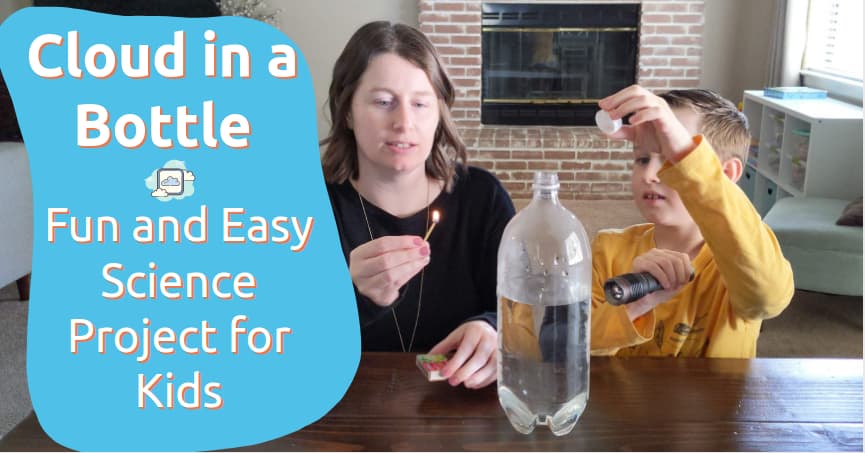
Perform the Egg and Soda Science Fair Experiment
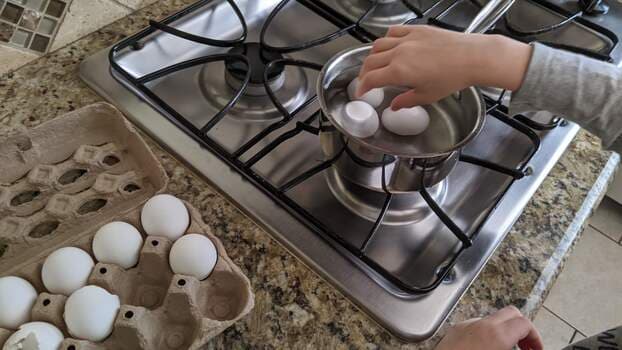
It’s a straightforward experiment that can be performed by following the steps below.
- Boil the eggs, ensuring you have a few extra ones if some of them crack during boiling. A cracked shell on your hard-boiled egg will alter the outcome of the experiment.
- Help your child fill each of the plastic cups whereby one has water, another has diet soda, and the third contains regular soda.
- Once the eggs have boiled have your child put one in each plastic cup then leave them overnight.
- Check on the eggs the following day. You may need to pour out the liquid from each cup to examine how each egg has been affected. You’ll notice the egg in the cola has been stained.
- Discuss the changes you notice in each egg. Ask your child what they believe occurred and the solution to get the eggs back to their original state.
- Give your child some toothpaste and a toothbrush and have them attempt to brush the stains off the eggshell.
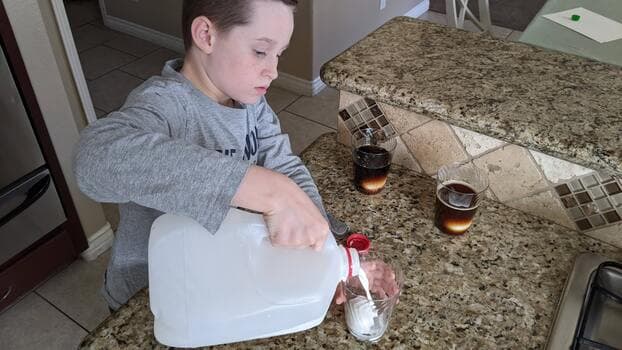
As a variation, you can boil a few additional eggs and add cups with coffee, clear soda, vinegar, and orange juice for comparison.
Understanding the Results of the Egg and Soda Science Fair Experiment
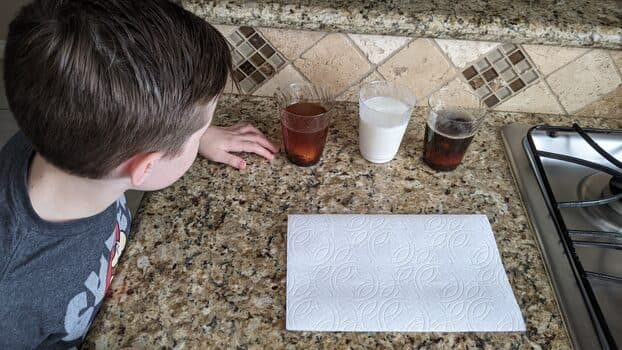
Each liquid provides essential information on how certain liquids negatively impact our teeth. The egg in water will have no changes because the acidity (pH) of water is close to your body’s resting PH. Water won’t break down your teeth, making it one of the healthiest liquids to consume.
Although the soda pop will result in softening of the outer shell of the egg, certainly not as much as vinegar. Most importantly, the soda pop will result in a discoloration of the white egg, particularly if the soda is dark. Its acid levels can result in the weakening or demineralization of the tooth enamel.
Lastly, the acidic level of vinegar is detrimental to your teeth during an acid attack. Every time you consume starch or sugar, the bacteria in your mouth utilize it to form the acid that is represented in a tooth decay experiment with vinegar.
The acidic vinegar breaks down the minerals in the eggshell just like acid does to the outer shell of your tooth. After a few days, there’s barely any shell left.
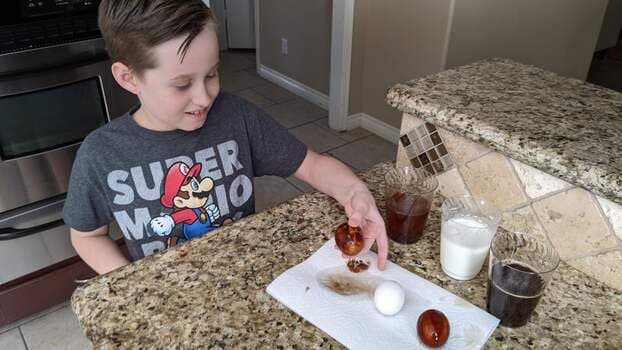
Preventing Tooth Decay
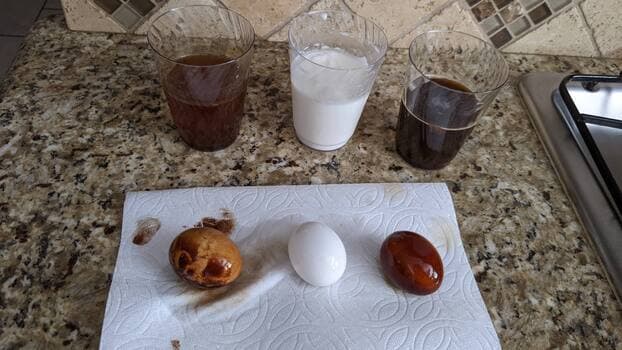
Aside from brushing your teeth every day, are there other ways to curb tooth decay? Although dentists recommend fluoride, how effective is it? You can find out by filling two clear jars with vinegar.
Then, coat one eggshell layer one eggshell entirely with gel fluoride toothpaste and put it in one jar, and put an uncoated eggshell in the second jar.
Keep an eye out for signs of decay on the uncoated eggshell as you note the condition of the coated eggshell. You shouldn’t notice decay on the coated eggshell.
The Takeaway
You and your child can learn two main things from this experiment. Firstly, the acid contained in soda and vinegar has the potential to severely erode tooth enamel.
Secondly, it takes more than just a few quick swipes with a toothbrush to get teeth spick-and-span. Therefore, incorporating healthy food choices in addition to brushing teeth every day with fluoride toothpaste is the key to preventing teeth erosion and decay.
Continue with the fun science experiments with some chemistry. Please take a look at our article full of fun and easy baking soda experiments for kids .
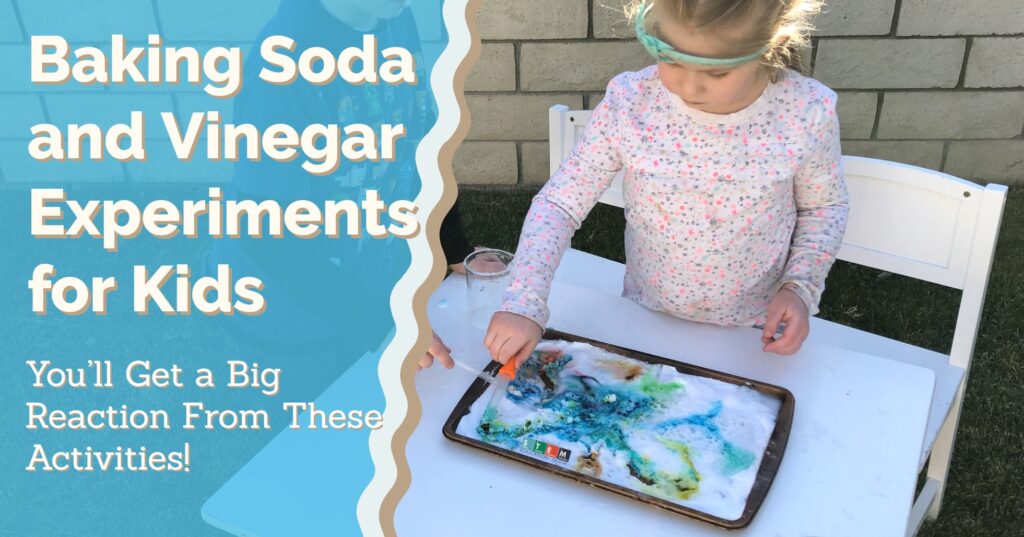
2 thoughts on “Egg and Soda Science Fair Experiment: Tooth Decay Project”
Marvelous, simple explanation
This is sooo helpful for me thank you.
Leave a Comment Cancel reply
Save my name, email, and website in this browser for the next time I comment.
most recent
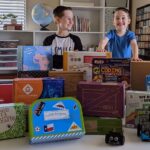
Activities and Games , Toy Gift Guides
Best stem subscription boxes for kids: hands-on reviews.
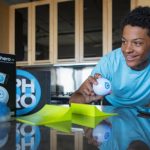
STEM Holiday Deals , Product Reviews
Best black friday deals for sphero.
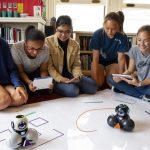
STEM Holiday Deals
Wonder workshop black friday deals (complete list of where and what to buy).
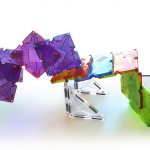
Product Reviews , Toy Gift Guides
Magna-tiles black friday deals: 2024.

Toy Gift Guides , Activities and Games , STEM Holiday Deals
Black friday stem toy deals 2024.
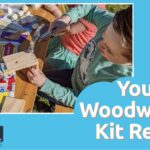
Activities and Games , Engineering
The young woodworkers kit club review (hands-on + coupon code).
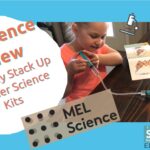
Science , Activities and Games
Mel science review (hands-on + coupon code).
STEM Education Guide
[email protected] STEM Education Guide 9125 SVL BOX Victorville, CA 92395
Your Compass for STEM Discovery
© 2024 STEM Education Guide
4 Fun Tooth-related Science Experiments for Kids

Have fun while learning about your teeth!
Are you looking for fun and engaging ways to get your kids excited about their dental health? Science experiments can be a great way to keep their attention and offer hands-on exploration.
These fun ideas can help you turn abstract ideas into tangible, real-world concepts that even the littlest chemists can grasp. Today, we’re sharing 5 of our favorite tooth-related science experiments, so you can turn your kitchen into a test lab today!
1. Elephant Toothpaste
This experiment is sure to bring out lots of “wows” from your crew! If they think brushing their own teeth is fun, think about how much toothpaste a huge elephant must use! This is one of our favorite science experiments for kids, and it’s always a big hit at home.
To create this oversized concoction, you’ll need to mix hydrogen peroxide with dish soap in one bowl. In another, you should mix dry yeast and warm water. When you combine the two mixtures, the result is an out-of-this-world “toothpaste” full of bubbles and foam.
You can even make the toothpaste colorful or striped by adding a few drops of food coloring to the peroxide and soap mixture. The full set of instructions can be found here . Be sure to do this one outside, where the paste has plenty of room to grow!
2. Bacteria “Tablets”
Plaque can be a difficult concept to explain to kids, especially because it can be hard to spot on their teeth. They’re at an age where they need to see to believe (except for the Tooth Fairy, of course!).
To encourage them to brush it away, try a simple experiment using disclosing tablets .
When your little ones chew these tasteless tablets, the plaque in their mouths will turn bright colors. This will give them a visual representation of where it’s clinging to their teeth so they can better understand the importance of good oral hygiene!
Some tablets will stain old plaque one color and new plaque another. The colors are temporary and wash away with gentle brushing and flossing, but the impactful reminder will last.
3. Eggs in Vinegar
Do your children understand how tooth decay can lead to cavities? While they may know to avoid a bunch of sugary sweets, they might not fully grasp why they need healthy teeth.
To explain the concept of tooth decay, try the classic Eggs in Vinegar experiment. This one explains how bacteria in your mouth produce acids that dissolve the calcium in your tooth enamel.
Start by hard-boiling a few eggs. Explain to your children that the hard outer shell protects the soft inside of the egg, much like our enamel protects the soft tissue (dentin) in our teeth. Leaving the shells on, place the eggs in cups of vinegar and cover the tops with plastic wrap to keep out any air.
Ask your kids to hypothesize what they think will happen. Will the vinegar eat away at the shell? Or will it stay intact?
On day one, you may not find much besides bubbles. Check back in a few days, however, and you’ll find that the shell is soft and pitted and may even be completely dissolved in some places. Reassure your children that the process takes much longer on their teeth and that brushing and flossing can keep that acid at bay!
4. Plaque Attack
Still have some dry yeast left over from the Elephant Toothpaste experiment? You can put it to good use with this fun Plaque Attack activity! This is a fun and exciting way to explain how sugars in our mouth can create plaque.
Start with two small plastic cups. In each cup, add two teaspoons of yeast. Then, stir one cup of warm water into each cup. Finally, add one tablespoon of sugar to one cup only.
Stir each mixture, then sit back and watch what happens. The cup without the sugar won’t show much activity, but the sugary version will grow a disgusting glob of brown foam!
To achieve the best results, make sure your water is warm, but not too hot. This way, it will fully activate the yeast and create the best, bubbliest Plaque Attack possible! Remind your kids that this reaction won’t happen in their mouth if they take care of their teeth and gums at home.
Try these tooth-related science experiments today!
Kids learn by doing and participating. This is true whether they’re playing outside or working in the classroom. If you’re looking for a new and interesting way to get them excited about dental health, these tooth-related science experiments are super fun !
Learn alongside them, encourage their work, and answer any questions they might have . Together, you can learn healthy habits that can keep their teeth and gums looking and feeling great for life.
Along the way, our dental team is here to help supplement and support your lessons. Contact us today to schedule an appointment!
- 513.424.5349
- Patient Forms

5 Toothy Science Experiments Kids Will Love
by Great Miami Dental | Apr 23, 2021 | General Interest | 0 comments
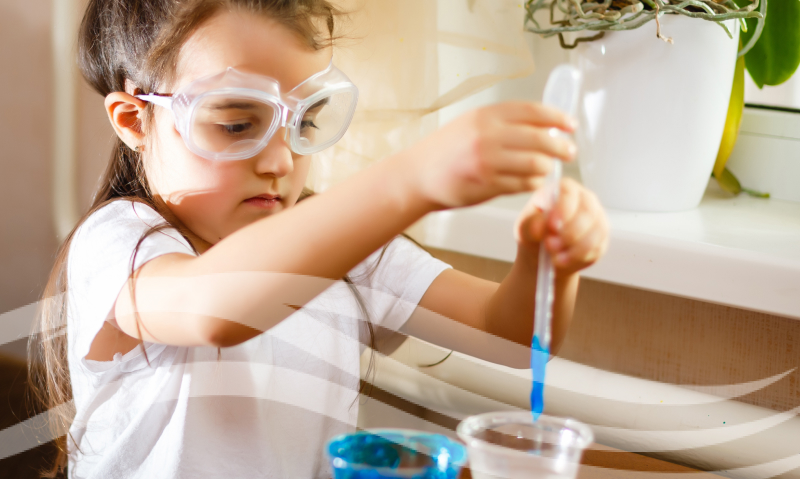
Dental Care Science Projects for Kids in Middletown, Ohio
Looking for a fun way to teach your child about the importance of good oral health and dental care? Dr. Steven A. Lang, DDS, has you covered. We’ve put together 5 of the best family-friendly toothy science experiments for you to try at home. Who knew brushing and flossing could be fun? We did! And if you’re really really lucky, one of these science experiments may just be the lightbulb moment that inspires your child to take better care of their teeth. You’ll never know until you try.
1. Elephant Toothpaste
Yes, you read that right: elephant toothpaste. This classic experiment creates a steaming tube of foam that resembles a large mammal’s brushing paste. It’s a great way to help kids start thinking of toothpaste as a fun addition to their oral routine that even elephants use. To start this science experiment, here’s what you’ll need:
- An empty plastic bottle (15 to 20 oz)
- 3% hydrogen peroxide
- A packet of dry yeast
- A cup of warm water
- Liquid dishwashing soap
- Food coloring
Step 1: Pour a 1/4 cup of dishwashing soap, 1/2 cup of hydrogen peroxide, and ten drops of food coloring into the plastic bottle. Swirl it around a bit.
Step 2: In another clean container, mix the dry yeast with a cup of warm water. Let it sit for five minutes.
Step 3: Now, the best part starts! Add the contents of the water yeast mixture to the plastic bottle. A big foam will start rising up the funnel almost immediately.
2. Homemade Toothpaste
Raise your virtual hand if you’ve ever made your own toothpaste? No? Great, now’s the perfect time to change that. Try this homemade toothpaste science project with your kids, and you may just spark an interest in creating a good oral hygiene routine. What you’ll need:
- 1 teaspoon salt
- 4 teaspoons baking soda
- 4 to 5 drops of peppermint or vanilla extract
- A plastic spoon
- A small cup
Step 1: Place the baking soda into the small cup and mix it with the salt.
Step 2: Add the peppermint or vanilla extract.
Step 3: Slowly pour water into the mixture until a paste starts to form.
Step 4: Try brushing your teeth using the homemade paste.
Toothpaste science experiments are fun although you’ll notice that it may not taste as nice as the one you bought at the store, but it’ll definitely get the job done.
3. Have a toothpaste showdown.
Which toothpaste do you use? Does it kill harmful bacteria and protect your teeth? Is your toothpaste truly the best there is? This science experiment will answer all these questions. Here’s what you’ll need:
- 3 different brands of toothpaste (the one you use and two others)
- 9 small white stone tiles
- A toothbrush
- A glass of orange juice
- A glass of grape juice
- A cup of tea or coffee
- Three glass bowls that are large enough to hold the stone tiles
Step 1: Put the three tiles into each of the glass bowls.
Step 2: Add coffee or tea to one bowl, grape juice to another, and orange juice to the last one.
Step 3: Allow the tiles to sit in the liquids for at least 24 hours. Then, put one tile from each bowl into one pile, making three groups.
Step 4: Brush the first group of tiles with one toothpaste, the second with a different paste, and the last pile with the third brand of paste. Rinse each tile just like you would your mouth after brushing your teeth.
The brand that removes the most stains from all three tiles is the winner of our toothpaste showdown.
4. Brush up on your teeth-cleaning skills.
Parents who have ever wrangled a toddler and pried their jaws apart in the hopes of passing a toothbrush over at least one tooth can attest to how much of an eternity two minutes can feel like. Let’s help you turn this mundane task into a fun activity you and your child can do together through this toothy science experiment. You’ll need:
- The toothbrush you use at home
- One piece of floss that’s at least 12 inches long
- A plaque disclosing tablet. Residents of Middletown, Ohio, can get one from Dr. Lang.
Step 1: Brush your teeth as you normally do using your toothbrush and toothpaste.
Step 2: Chew one plaque disclosing tablet for 30 seconds.
Step 3: Spit the plaque disclosing tablet out. DO NOT SWALLOW IT!
Step 4: Examine your teeth in the mirror. Notice any colorful spots? That’s where plaque and harmful bacteria are.
Step 5: Brush your teeth again, this time paying more attention to the areas with spots.
Pro tip: You’ll have some extra disclosing tablets left. Try this experiment again using a different toothbrush or another brand of toothpaste. Make a game of it to see who’ll have the least colorful spots. And if you’re lucky, the days of bribery and coercion to get your child to brush or floss will soon be but a memory.
5. Plaque Attack
Now this one may just be gross enough to get your kids reaching for their toothbrush. Here’s what you’ll need:
- 4 teaspoons yeast
- 2 cups of warm water
- 1 tablespoon sugar
- 2 plastic spoons
Step 1: Add two teaspoons of yeast into each cup of warm water. Pour sugar into one of the cups.
Step 2: Use separate spoons to stir the mixture.
Can you tell which cup you added sugar to? Yes! The one with a brown disgusting foam resembling plaque. That’s what happens when sugar particles accumulate in your mouth.
At Great Miami Dental, we care for your family by caring for your smiles.
Try the toothy science experiments in this article and let us know which one was your favorite on our Facebook page . If you have any other questions about your oral health or at-home dental care, feel free to book an appointment with us. We’ll care for your family by caring for your smiles.
Want Family-Friendly Health Tips?
Check your inbox or spam folder to confirm your subscription.
Recent Posts
- Healthy Gums, Happy Kids: Understanding and Preventing Gum Disease
- Why Now Is the Perfect Time to Schedule Your Family’s Next Dental Cleaning!
- Top 5 Signs It’s Time to Visit Your Dentist for Toothache Relief
- Meet Dr. Lori Zuptich, Your Great Miami Dental Associates Dentist in Middletown, Ohio
- Is It Really True? Same Day Crowns All in One Day?
- November 2024
- October 2024
- September 2024
- August 2024
- February 2024
- January 2024
- December 2023
- November 2023
- October 2023
- September 2023
- August 2023
- February 2023
- January 2023
- December 2022
- November 2022
- October 2022
- September 2022
- August 2022
- February 2022
- January 2022
- December 2021
- November 2021
- October 2021
- September 2021
- August 2021
- February 2021
- January 2021
- December 2020
- November 2020
- October 2020
- September 2020
- August 2020
- February 2020
- January 2020
- December 2019
- November 2019
- October 2019
- September 2019
- August 2019
- February 2019
- January 2019
- December 2018
- Cosmetic Dentistry
- General Dentistry
- General Interest
- Local Interest
- Oral Health
- Restorative Dentistry

COMMENTS
Egg Brushing. Eggshells are made from calcium, so they make an easily accessible comparison to tooth enamel for home science experiments. This experiment involves soaking hard-boiled eggs overnight in different types of liquids, including water, a dark-colored soda, and vinegar. Give your kids the chance to guess what they think will happen to ...
Instructions: Step 1: Take one apple and use the sharpened pencil to make five to 10 holes in it. Poke only one hole in the second apple and use the third apple as the control. Step 2: Put the apples in separate paper bags and let them stay there overnight. Step 3: Use a sharp knife to cut all the apples in half.
The acids in many beverages can have a damaging effect on your teeth. Demonstrating this makes a great science project for school science fairs or classes. If you have lost a baby tooth lately, you could experiment on actual teeth, but if not you can substitute eggshell. Eggshell is not as tough as human teeth, as it lacks a layer of enamel, but it does provide a graphic example of the effect ...
1. Toothpaste Eruption. Materials: Instructions: Set up the experiment area on a tray or covered surface. Mix a tablespoon of baking soda with dish soap in each small container. Optionally, add food coloring for a colorful eruption. Have kids spread the mixture onto tooth models or cutouts using craft sticks or spoons.
Pour the same amount of fizzy drink, vinegar, water and tea or coffee into your jars. Add a whole raw egg still in it's shell to each, cover an extra egg with toothpaste and also place in tea/coffee. Leave for approximately three days. Remove the eggs. Rinse the egg kept in vinegar and rub gently until the shell comes away.
Sugar and acids are very harmful to teeth. Acids actually dissolve the enamel, giving bacteria an inroad to begin decaying it, and sugar promotes tooth decay (cavities). Of course, the water egg was the best after 24 hours. But take a look at the Gatorade egg:
Make a dental impression in modeling clay and study your incisors, canines, premolars and molars. This is an experiment about human teeth. Fun and easy science experiments for kids and adults. ... contains: 2 incisors, 1 canine and 2 molars. This makes a total of 20 baby teeth. The second set of teeth - the permanent teeth - replaces the ...
A cracked shell on your hard-boiled egg will alter the outcome of the experiment. Help your child fill each of the plastic cups whereby one has water, another has diet soda, and the third contains regular soda. Once the eggs have boiled have your child put one in each plastic cup then leave them overnight. Check on the eggs the following day.
1. Elephant Toothpaste. This experiment is sure to bring out lots of "wows" from your crew! If they think brushing their own teeth is fun, think about how much toothpaste a huge elephant must use! This is one of our favorite science experiments for kids, and it's always a big hit at home. To create this oversized concoction, you'll need ...
To start this science experiment, here's what you'll need: Step 1: Pour a 1/4 cup of dishwashing soap, 1/2 cup of hydrogen peroxide, and ten drops of food coloring into the plastic bottle. Swirl it around a bit. Step 2: In another clean container, mix the dry yeast with a cup of warm water. Let it sit for five minutes.